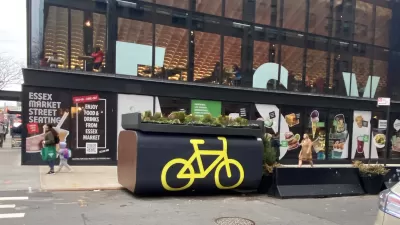Widely available, secure bike parking can go a long way toward encouraging cycling and keeping New Yorkers safe, a new report says.

A report from Transportation Alternatives blasts the de Blasio administration for failing to meet its bike parking goals for New York City. Gersh Kuntzman, writing for Streetsblog NYC, reveals that the city failed to deliver on many of its plans to improve bicycle parking and vastly underperformed in all aspects of its bike parking promises. As more New Yorkers choose bicycles in what amounts to a "historic cycling boom," the lack of adequate bike parking has led to a 27% increase in bike theft, and, the report argues, an overall drop in cycling.
According to Transportation Alternatives, the lack of secure parking also undermines local businesses. In a 2010 study on spending done by cyclists, the space taken up by one car generated more than three times as much local spending when converted to bike parking. In that study, "even when the bike parking was less than 30 percent occupied, it still generated the same spending as the missing car spaces."
The report's recommendations include—most obviously—building more bike parking with a focus in low-income communities, more bike corrals at intersections (where they provide more visibility than parked cars), allowing developers to build bike parking to meet parking requirements in new buildings, and promoting more public and private options for paid secured bike parking, which can help raise revenue and provide safe parking for cyclists.

Study: Maui’s Plan to Convert Vacation Rentals to Long-Term Housing Could Cause Nearly $1 Billion Economic Loss
The plan would reduce visitor accommodation by 25,% resulting in 1,900 jobs lost.

North Texas Transit Leaders Tout Benefits of TOD for Growing Region
At a summit focused on transit-oriented development, policymakers discussed how North Texas’ expanded light rail system can serve as a tool for economic growth.

Why Should We Subsidize Public Transportation?
Many public transit agencies face financial stress due to rising costs, declining fare revenue, and declining subsidies. Transit advocates must provide a strong business case for increasing public transit funding.

How to Make US Trains Faster
Changes to boarding platforms and a switch to electric trains could improve U.S. passenger rail service without the added cost of high-speed rail.

Columbia’s Revitalized ‘Loop’ Is a Hub for Local Entrepreneurs
A focus on small businesses is helping a commercial corridor in Columbia, Missouri thrive.

Invasive Insect Threatens Minnesota’s Ash Forests
The Emerald Ash Borer is a rapidly spreading invasive pest threatening Minnesota’s ash trees, and homeowners are encouraged to plant diverse replacement species, avoid moving ash firewood, and monitor for signs of infestation.
Urban Design for Planners 1: Software Tools
This six-course series explores essential urban design concepts using open source software and equips planners with the tools they need to participate fully in the urban design process.
Planning for Universal Design
Learn the tools for implementing Universal Design in planning regulations.
Ascent Environmental
Borough of Carlisle
Institute for Housing and Urban Development Studies (IHS)
City of Grandview
Harvard GSD Executive Education
Toledo-Lucas County Plan Commissions
Salt Lake City
NYU Wagner Graduate School of Public Service




























